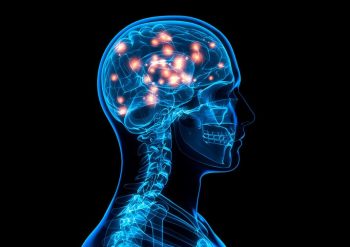Contributing writer for Wake Up World
The less inflammatory your diet is, the faster you’re going to get well, because inflammation is nearly always a contributor to neurological dysfunction.
Your brain is a really important part of your body. I’m sure no one would disagree with that. In this interview, Dr. Lee Cowden, cofounder of the Academy of Comprehensive Integrative Medicine (ACIM), discusses some really simple and inexpensive strategies that boost brain health and support neuroregeneration. This is also the topic of this year’s ACIM conference, which will be held in Orlando, Florida, in November.
The Academy of Comprehensive Integrative Medicine was founded in 2008 with the vision of educating integrative practitioners around the globe, for the most part online. “Many practitioners are so busy that they can never take the time to go to all of the meetings they need to go to, to learn what they need to learn,” Cowden says, “so we decided to start putting educational courses online.”
[pro_ad_display_adzone id=”110028″]
ACIM Offers Training Programs for Laypeople and Health Care Professionals Alike
In 2014, ACIM began offering a 300-hour online integrative medicine fellowship training program. Workshops are held in Dallas every few months to allow practitioners to get hands-on training. This year, there are hands-on conferences July 19 through 21, and September 20 through 22. Those are all preludes to the main conference in Orlando November 8 through 11.
“Everything we’re doing this year is focused on the brain [and] neuroregeneration,” Cowden says. “With integrative medicine, we look at the causation, and see if we can resolve the causation of the illness. Once the cause goes away, usually the illness goes away.”
If you’re a health care professional, I strongly encourage you to attend the November conference and get involved with ACIM. But you don’t have to be a health care professional to benefit from ACIM. Even laypeople can study with ACIM. The academy offers a core wellness coach program that includes 70 hours of training. “I think every integrative practitioner needs to have half a dozen or more wellness coaches working with them to hold the hands of the patients until they get well,” Cowden says.
ACIM Conference 2018: Neuroregeneration
The November conference will focus on strategies that can help regenerate all types of neurological conditions, including Alzheimer’s, autism, multiple sclerosis, amyotrophic lateral sclerosis, Parkinson’s disease and other less severe conditions such as the neurological effects of fibromyalgia, and less common conditions such as reflex sympathetic dystrophy and peripheral neuropathy.
“We also are going to focus on what can be done to help people who are given no hope, who have chronic psychiatric conditions, like post-traumatic stress disorder, psychosis, neurosis, insomnia and other conditions. We’re going to cover the gamut in the conference in November.
The tendency of the American public is to look for a magic bullet. But, really, for neurological diseases, I haven’t found a magic bullet. There’s a lot of very important pieces. I call those the foundational pieces: Diet, removing electromagnetic fields (EMFs) from the patient’s surroundings, physical activity, as well as brain games. There are a lot of other emotional issues that impact chronic neurological conditions that we need to address as well.”
Quenching Inflammation is a Key Fundamental Step
In regard to diet, the less inflammatory it is, the faster you’re going to get well, because inflammation is nearly always a contributor to neurological dysfunction. The most inflammatory of all foods is probably sugar, followed by damaged, oxidized omega-6 oils, trans fats and processed vegetable oils. These all need to be strictly avoided. In addition to an anti-inflammatory diet, nutritional and herbal supplements can offer targeted support.
“Eating a ketogenic diet with clean fats and oils, doing some [intermittent] fasting throughout the week and getting rid of the inflammation-creating things — sugars, omega-6 oils, peanut products that have high arachidonic acid and so on … can make a great start in getting a patient’s neurological condition improved,” Cowden says.
“In 1988, I had a colleague who had a father in a nursing home in Louisiana who had advanced Alzheimer’s. He was a full-care case. In the morning, the nurses would have to get him out of bed, dress him and feed him. He was always pooping and peeing in his pants. He couldn’t remember the names of the nurses, the family members or anybody. My colleague said, ‘Can you give me some ideas of things that will help my father?’
I said, the problem is that it’s going to take a lot of intervention, and getting that at a nursing home is not likely to happen. He said, ‘I’m pretty sure it will happen, because the head nurse of the nursing home has a mother, just like my dad, with severe dementia. She wants to see if what I try on my dad works, so that she can try it on her mom.’
I recommended a regimen: Dietary changes, supplemental nutrients and proteolytic enzymes 30 minutes before food, magnesium, vitamin D3, tocotrienols, tocopherols, bacopa monieri, other herbs, homeopathics and some things to get the metals out … chlorella … dimercaptosuccinic acid (DMSA) and so on. I said, ‘You need to get your dad out of bed and walk him every day. Get the nurses to do this. Get them to play brain games with him.’
He called me back about four months later. He said, ‘I’ve got to give you an update on this … My dad now gets out of bed, dresses himself, feeds himself, does not poop or pee in his pants anymore. He walks around with the nurses and helps them take care of the other patients in the nursing home. Then he sits down and plays cards with the nurses, and sometimes wins.’ That’s a big shift in just four months’ time, [and] we’ve had lots of other cases like that with dementia.”
Can You Reverse Autism?
Cowden has also seen near-magical improvements in children with autism. A remarkable case is that of a young man named Bryan. Cowden first met Bryan’s dad when Bryan was just 7 years old. He had neither speech nor socialization skills.
His dad was a restaurant owner who went back to school to become a naturopathic doctor in a desperate attempt to help his son after all of his allopathic doctors told him there was no hope for Bryan — he’d never graduate high school, go to college, hold a job, get married or have children of his own.
Cowden worked with Bryan’s father, and not only did Bryan start speaking within a year or two, he graduated high school at 18, played football in college on a scholarship and got B’s in school. After college, he became a massage therapist; fell in love, married and had two children. He is now helping autistic children and adult patients with neurological disease to recover. I’ve met Bryan, and this story is all the more remarkable by the fact that he’s one of the healthiest people I have ever met.
There is a very objective heart rate variability test that measures the fitness of your autonomic nervous system and a variety of other variables called HeartQuest. Bryan scored virtually a perfect score on this test. From being an autistic child at age 7 to someone who’s one of the healthiest people around is a rather dramatic example showing that if you apply these principles, they really can work.
“After his dad helped him get to the point where he was able to do a lot of things for himself, Bryan became highly motivated to eat a clean diet, to do a physical activity, to drink enough water, to get enough sleep and so on,” Cowden notes. “He lives right.”
A Simple Stress Reduction Technique That Pays Dividends
The beauty of integrative medicine is that there are literally hundreds if not thousands of tools available, and sometimes the simplest, least expensive ones are among the most effective. One fundamental aspect of good health is stress reduction. A stress reduction technique I learned from Cowden that has helped me decrease my sleep latency, allowing me to fall asleep really quickly when done before bed, is performed as follows:
- Place your left index finger and thumb together, then grasp a hold of these two fingers with your right hand (see video demonstration starting around 29:55). It’s important to use your left fingers, as the left side of your body entrains the right side of your body rather quickly, whereas the right side entrains the left very slowly.
- Place your hands on your lap and breathe deeply in through your nose. Hold your breath for one second before breathing out through your mouth. Keep breathing in through your nose and out through your mouth while visualizing yourself in the most relaxing place you have ever been. Be sure to include sound, taste, touch and smell in your visualization and not just the visual component. Really remember that place with all of your senses.
Doing this for four to five minutes before each meal will help improve your digestion and absorption of nutrients, boost your immune function and relax your body. Done before bedtime, it’ll improve how fast you fall asleep, how deeply you fall asleep, and the amount of healing your body can get while asleep as it boosts your immune function. For very little time, energy and effort, at no cost, you can get a lot of improvement. Cowden explains the rationale for these specific finger holds:
“On the index finger, on the middle-finger finger side, the dorsal surface, is the energy pathway for your nervous system. On the palm-side surface of the index finger is the energy pathway for your neurotransmitter system. On the thumb, on the outer aspect, is the pathway for your lymphatic system. Everybody who is chronically stressed has a stressed-out nervous system, stressed-out neurotransmitters and a clogged lymphatic system.
When you hold [your left index finger and thumb] with your right hand, you’re taking the excess energy that’s usually in these other pathways and dissipating that into the pathways that run on the palm surface of your right hand. If there are areas or pathways that are deficient in energy, then energy comes out of the pathways in your right hand and goes into the pathways in your left hand.
The principle is balancing the energy pathways. The Chinese have said for 3,000 years that disease develops whenever energy stagnates. If you stagnate energy, then you’re going to have all kinds of problems, including maldigestion and insomnia … This helps, probably more than anything I’ve found, to balance the sympathetic and parasympathetic nervous system.
The sympathetic is what causes the fight-or-flight. The parasympathetic, which is to balance out the sympathetic, is responsible for digestion, relaxation, sleep and the calming parts of our nervous system. So many people have almost exclusively, sympathetic and almost no parasympathetic function.”
5-HTP Boosts Melatonin and Helps Optimize Sleep
Another gem I learned from Cowden during a visit to my home was the use of 5-hydroxytryptophan (5-HTP). My deep sleep measured at zero minutes, despite spending time at the beach daily to expose myself to bright sunshine and using blackout drapes to sleep in the dark. I also turned off the electricity to my bedroom. I thought that’s all you needed to optimize melatonin. It turns out that’s not the case when you get older. Cowden explains:
“Tryptophan, which you find in turkey and pumpkin seeds, gets converted to 5-HTP. 5-HTP is converted to 5-hydroxytryptamine, also called serotonin. 5-hydroxytryptamine finally gets converted into melatonin. However, as we age, toxins pile up in the enzymes [responsible for these conversions] and prevent those enzymes from performing the work they need to do.
You have, over time, lower and lower levels of 5-HTP, serotonin and melatonin, even though you’re doing everything else right. So, yes, we have to continually detoxify, and also, sometimes, support those enzyme systems by what we call excessive precursor supply. You boost the building blocks to make the final product.
Melatonin is not very well absorbed out the gut. Some people take melatonin, but some people have kind of a paradoxical response from that. But if they take 5-HTP, they can actually make as much 5-hydroxytryptamine as they need to fairly easily, and then they have the serotonin and melatonin.”
[pro_ad_display_adzone id=”110030″]
Low Serotonin Will Impede Melatonin Production
Once I began taking 100 milligrams of 5-HTP about 20 minutes before bed, my deep sleep rapidly increased to about 30 minutes a night. Since then I’ve also painted my bedroom with grounded shielding paint that provides an ultra-low EMF environment. Turning off the electricity wasn’t enough, as assessed by measuring the electric field’s influence on my body voltage. Hopefully that’ll improve my deep sleep further.
Many are aware that serotonin is important for mood, but if you don’t have enough of it, you can’t make melatonin either, and melatonin is the most important antioxidant nutrient in the brain. As noted by Cowden, melatonin is far more important than the oral antioxidants you may take. It’s even more important than glutathione and superoxide dismutase, because it’s fat-soluble.
Melatonin provides the best protection for your neurons against free radical damage, and you need a healthy release of melatonin through the night to calm and heal your brain. The enzyme that converts 5-HTP to serotonin requires vitamin B6 as a cofactor, so if you’re taking 5-HTP and not seeing results, that means you probably need to take some coenzymated B6 (pyridoxal 5′-phosphate) sublingually to get enough of the active form of B6 to enable the conversion of 5-HTP to serotonin.
The Many Benefits of Magnesium
Another supplement that is helpful for sleep is magnesium. Cowden prefers magnesium malate, which is what I use, but you can also use magnesium threonate. There are literally dozens of different types of magnesium supplements. Magnesium threonate has the added benefit of providing some antiretroviral activity, and retroviruses tend to be a challenge inherent with many neurodegenerative diseases. Threonate is also a neurotransmitter, in addition to being an amino acid.
To avoid creating an imbalance, it’s wise to alternate between different forms of magnesium. Cowden prefers magnesium malate because malic acid is a Krebs citric acid cycle intermediate and actually helps generate more ATP energy. If you’re deficient in malic acid inside the cell and you take a magnesium malate, the malic acid is drawn into the interior of the mitochondria and will drag the magnesium in with it.
Without a doubt, magnesium is essential for mitochondrial ATP production. About 50 percent of the metabolic enzymes in your body require magnesium as a cofactor, so it’s a really important nutrient. It’s also required for conduction of nerve impulses and the contraction-relaxation cycle of muscles, including your heart muscle.
There’s also compelling evidence suggesting magnesium may reduce the impacts and side effects of EMF exposure. Importantly, if you don’t have enough magnesium, your body also cannot absorb potassium. Cowden explains:
“If a person is deficient in magnesium and potassium both, you can give them potassium in large amounts on an ongoing basis, and their potassium levels never come up. But if you give them magnesium and get it repleted, and then give them potassium, then their potassium levels come up.
That’s because the kidney tubules selectively hold on to magnesium and waste potassium into the toilet in order to retain the magnesium. Because, apparently, the body sees the magnesium as being a more vital nutrient than potassium.
One more thing. A lot of people in the United States are on some form of diuretic medication, either for blood pressure, swelling of their legs or for some other reason. When you take a diuretic, it has a magnesium- and potassium-wasting effect on the kidneys. They’re wasting both magnesium and potassium into the toilet. But most doctors only give potassium. They don’t give the magnesium.”
Alternatives to Diuretics
Diuretics are frequently prescribed for high blood pressure and/or swelling in the extremities. As in most cases, drugs are not necessary for treating these conditions. Swelling of the legs is often due to congestion in your lymphatic system, or kidney toxicity preventing your kidneys from properly processing water. Hence the water is retained in your tissues. Sometimes, it’s just severe toxicity in the tissues.
“One of the ways the body protects itself from toxic overload is to allow water to go out into the tissues where the toxins are, to dilute the toxins. If you have enough toxicity in your legs, then you’re going to have fluid accumulation there to try to dilute those toxins,” Cowden explains. “The lymphatic system can get clogged up for lots of different reasons.
The lymphatic system is commonly clogged up in people in the United States, because they have a love affair with dairy products and wheat products, both of which produce thick sticky mucoid material in the lymphatic system, which clogs it up. If they’ll get rid of the dairy and wheat products, then the lymphatic system becomes more fluid and able to clear toxins from the tissues through the lymphatic system.”
If you have an extremely weak heart, you may not be able to pump blood properly. This is also known as right-sided congestive heart failure. A very common cause of that is coenzyme Q10 (CoQ10) deficiency. According to Cowden, taking CoQ10, addressing any emotional issues and eliminating heavy metals will help the swelling to go away even in these more serious cases.
Why Diuretics are Not Ideal for Treatment of Hypertension
Hypertension is a more complex issue. The first line of treatment and the No. 1 recommended drug for treating hypertension is thiazide diuretic. However, thiazide diuretics cause chromium wasting, which then creates insulin resistance, which in turn raises your blood pressure. As noted by Cowden:
“That seems to be a pretty oxymoronic way to do that. We really need to try to find a better solution. Most people who have hypertension emotionally feel under pressure to do something or not do something. If they can recognize what that is and resolve that emotional conflict, their blood pressure usually goes down quite a bit …
If you get the plaque reversed in the arteries, then the [arteries] are no longer stiff, so then you don’t have a systolic hypertension. You don’t need the drug, because your blood pressure comes down just by getting rid of the plaque in the arteries.
How do you do that? In the early ’90s, I was giving patients with advanced atherosclerotic disease proteolytic enzymes 30 minutes before food, a clean diet, supplements, nutrients, magnesium, vitamin C, vitamin E, etc., and reversing 80 to 90 percent plaque in the arteries down to 20 and 30 percent plaque in just three or four months.
We proved that with the ultrasound Doppler duplex imaging. If we can do that, then why are we doing open heart surgeries, carotid endarterectomies and all that other stuff? It’s because people are not educated about what’s possible. If they haven’t been told that this could be done by their medical doctor, then they don’t believe that it’s possible. Unfortunately, there are a lot of things the medical doctor doesn’t know, because they weren’t taught it in medical school.”
The Benefits of Proteolytic Enzymes
Proteolytic enzymes are an effective strategy not only for decreasing atherosclerotic plaque but also for thinning your blood, lowering your risk of a blood clot. Cowden’s father was placed on Coumadin by his doctor, which caused him to bleed profusely whenever he hurt himself working outside. Cowden suggested proteolytic enzymes instead, which his father was eager to try.
“He started that when he was about 60. He lived to be 80. He was on proteolytic enzymes 30 minutes before food twice a day for 20 years, without any more clots, without any more of the symptoms for which he was being treated with the sodium warfarin or the Coumadin.
Since then, I’ve treated several dozen other patients with the same strategy. As far as I know, there’s no peer-reviewed literature proving that this is so, but we have lots of anecdotal evidence … As far as I know, everybody has remained plaque-free.”
The enzymes Cowden uses for this purpose, in order of effectiveness are:
- Lumbrokinase, made from bacteria that live in the gut of the earthworm
- Nattokinase, a fermented soy product
- Serrapeptase, made from bacteria that grow in the gut of the silkworm
- Bromelain, obtained from pineapple stems
- Papaya leaf enzyme
“A person can be energetically tested for several of these enzymes to see which pair is the best pair and just rotate back and forth. Monday, Wednesday and Friday, one; Tuesday, Thursday, Saturday and Sunday the other. If they do enough of those, then usually they’ll have no clot formation,” he says. Proteolytic enzymes also combat tiny clots, frequently caused by chronic infections. The infection, wherever it is located, causes your body to produce excessive amounts of fibrin, a clot-producing agent.
This fibrin can plaster itself up against the capillary walls, restricting the delivery of oxygen from red blood cells through the capillary wall into the tissues.
The above-mentioned enzymes will strip away fibrin, allowing oxygen delivery through the capillary walls into tissues. Once the tissues are no longer starved of oxygen, they can go into aerobic metabolism instead of anaerobic metabolism, and when you’re in anaerobic metabolism, you don’t stimulate cancer growth and microbial growth. So, there are many related health benefits.
Recommended articles by Dr. Joseph Mercola:
- Harvest of Greed – The Merger of Bayer and Monsanto
- Aspartame: The Bitter Truth Behind This Toxic Sweetener
- Why Depression is NOT Caused by a Chemical Imbalance
- Toxic Weed Killer Glyphosate Found in Most Foods Sold in the U.S.
- The Harmful Effects of Electromagnetic Fields Explained
- The Magic Healing Power of Mushrooms
- Ghost in the Machine: How Big Pharma Controls Our Perception of Drug Safety and Effectiveness
- 13 Mind-Body Techniques That Can Help Ease Pain and Depression
- Vitamin D Deficiency Linked to Dementia and Alzheimer’s Disease
- Baking Soda — An Inexpensive Treatment for Autoimmune Diseases Like Arthritis
About the author:
Born and raised in the inner city of Chicago, IL, Dr. Joseph Mercola is an osteopathic physician trained in both traditional and natural medicine. Board-certified in family medicine, Dr. Mercola served as the chairman of the family medicine department at St. Alexius Medical Center for five years, and in 2012 was granted fellowship status by the American College of Nutrition (ACN).
While in practice in the late 80s, Dr. Mercola realized the drugs he was prescribing to chronically ill patients were not working. By the early 90s, he began exploring the world of natural medicine, and soon changed the way he practiced medicine.
In 1997 Dr. Mercola founded Mercola.com, which is now routinely among the top 10 health sites on the internet. His passion is to transform the traditional medical paradigm in the United States. “The existing medical establishment is responsible for killing and permanently injuring millions of Americans… You want practical health solutions without the hype, and that’s what I offer.”
Visit Mercola.com for more information, or read Dr. Mercola’s full bio and resumé here.
[pro_ad_display_adzone id=”110027″]








